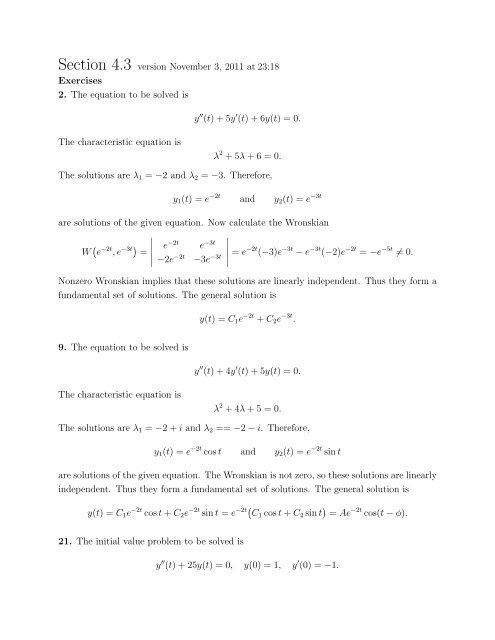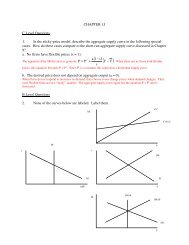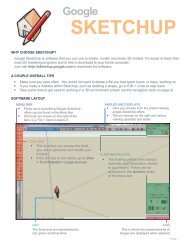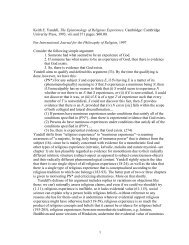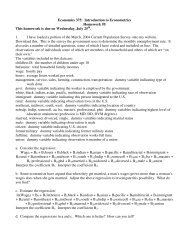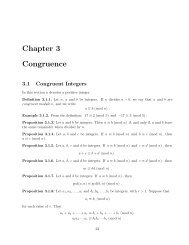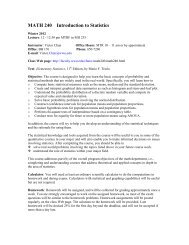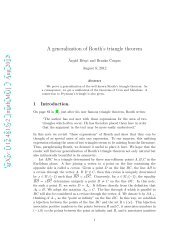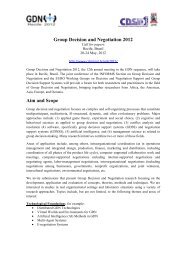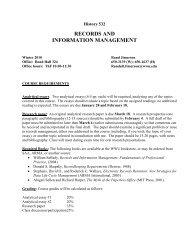Section 4.3 version November 3, 2011 at 23:18 Exercises 2. The ...
Section 4.3 version November 3, 2011 at 23:18 Exercises 2. The ...
Section 4.3 version November 3, 2011 at 23:18 Exercises 2. The ...
You also want an ePaper? Increase the reach of your titles
YUMPU automatically turns print PDFs into web optimized ePapers that Google loves.
<strong>Section</strong> <strong>4.3</strong> <strong>version</strong> <strong>November</strong> 3, <strong>2011</strong> <strong>at</strong><strong>23</strong>:<strong>18</strong><strong>Exercises</strong><strong>2.</strong> <strong>The</strong> equ<strong>at</strong>ion to be solved isy ′′ (t)+5y ′ (t)+6y(t) = 0.<strong>The</strong> characteristic equ<strong>at</strong>ion isλ 2 +5λ+6 = 0.<strong>The</strong> solutions are λ 1 = −2 and λ 2 = −3. <strong>The</strong>refore,y 1 (t) = e −2t and y 2 (t) = e −3tare solutions of the given equ<strong>at</strong>ion. Now calcul<strong>at</strong>e the WronskianW ( ∣e −2t ,e −3t) e −2t e −3t ∣∣∣∣== e −2t (−3)e −3t −e −3t (−2)e −2t = −e −5t ≠ 0.∣ −2e −2t −3e −3tNonzero Wronskian implies th<strong>at</strong> these solutions are linearly independent. Thus they form afundamental set of solutions. <strong>The</strong> general solution isy(t) = C 1 e −2t +C 2 e −3t .9. <strong>The</strong> equ<strong>at</strong>ion to be solved isy ′′ (t)+4y ′ (t)+5y(t) = 0.<strong>The</strong> characteristic equ<strong>at</strong>ion isλ 2 +4λ+5 = 0.<strong>The</strong> solutions are λ 1 = −2+i and λ 2 == −2−i. <strong>The</strong>refore,y 1 (t) = e −2t cost and y 2 (t) = e −2t sintare solutions of the given equ<strong>at</strong>ion. <strong>The</strong> Wronskian is not zero, so these solutions are linearlyindependent. Thus they form a fundamental set of solutions. <strong>The</strong> general solution isy(t) = C 1 e −2t cost+C 2 e −2t sint = e −2t( C 1 cost+C 2 sint ) = Ae −2t cos(t−φ).21. <strong>The</strong> initial value problem to be solved isy ′′ (t)+25y(t) = 0, y(0) = 1, y ′ (0) = −1.
First we find the general solution. <strong>The</strong> characteristic equ<strong>at</strong>ion isλ 2 +25 = 0.<strong>The</strong> solutions are λ 1 = 5i and λ 2 = −5i. <strong>The</strong>refore,y 1 (t) = e 5it and y 2 (t) = e −5itare solutions of the given equ<strong>at</strong>ion. But, we are interested in real solutions. So, use Euler’sformula to get the real and imaginary part:y 1 = e 5it = cos(5t)+isin(5t) and y 2 = e −5it = cos(5t)−isin(5t).As we showed in class the real part and the imaginary part of these functions are alsosolutions of the given equ<strong>at</strong>ion. Now calcul<strong>at</strong>e the WronskianW ( cos(5t),sin(5t) ) cos(5t) sin(5t)=∣ −5sin(5t) 5cos(5t) ∣ = 5(cos(5t))2 +5(sin(5t)) 2 = 5 ≠ 0.Nonzero Wronskian implies th<strong>at</strong> cos(5t) and sin(5t) are linearly independent. Thus theyform a fundamental set of solutions of the given equ<strong>at</strong>ion. <strong>The</strong> general solution isy(t) = C 1 cos(5t)+C 2 sin(5t).To solve the initial value problem we find the deriv<strong>at</strong>ive first:y ′ (t) = −5C 1 sin(5t)+5C 2 cos(5t).Now we use the initial conditions:1 = y(0) = C 1 ·1+C 2 ·0, −1 = y ′ (0) = −5C 1 ·0+5C 2 ·1.ThusC 1 = 1 and C 2 = − 1 5 .<strong>The</strong> solution of the given initial value problem isy(t) = cos(5t)− 1 5 sin(5t).But, much more preferable way to write the solution is in the form A cos(5t−φ). To do thiswe use complex numbers:cos(5t) = Re ( e 5it) , − 1 ( ) i5 sin(5t) = Re 5 e5it
Thuscos(5t)− 1 (5 sin(5t) = Re e 5it + i ) ((5 e5it = Re 1+ i ) )e 5it .5Now we convert 1+i/5 to polar form1+ i 5 = √1+ 1 25 eiθ =√26where θ = arctan ( 1/5 ) . Hence,(1+ i ) √ √26 26e 5it = e iθ e 5it = e i(5t+θ) ,5 5 5and thereforecos(5t)− 1 ((5 sin(5t) = Re 1+ i ) )e 5it5= Re5(√265e iθ ,e i(5t+θ) )=√265 cos( 5t+θ ) .Thus the solution isy(t) = cos(5t)− 1 5 sin(5t) = √265 cos( 5t−φ ) , where φ = −arctan ( 1/5 ) .Just to make sure th<strong>at</strong> the last two formulas represent the same function I plot them on thesame graph, see Figure 1.2<strong>2.</strong> <strong>The</strong> initial value problem to be solved isy ′′ (t)+10y ′ (t)+25y(t) = 0, y(0) = 2, y ′ (0) = −1.First we find the general solution. <strong>The</strong> characteristic equ<strong>at</strong>ion isλ 2 +10λ+25 = 0.<strong>The</strong>re is only one solution λ 1 = −5. <strong>The</strong> corresponding solution of the given differentialequ<strong>at</strong>ion isy 1 (t) = e −5t .As it is explained in the book the other solution is<strong>The</strong> solutionsy 2 (t) = te −5t .y 1 (t) = e −5t and y 2 (t) = te −5tare linearly independent since their Wronskian is nonzero:W ( ∣e −5t ,te −5t) e −5t te −5t ∣∣∣∣== e −10t −5te −10t +5te −10t = e −10t ≠ 0.∣ −5e −5t e −5t −5te −5t
1.51.0.5Π10Π53Π102Π5Π<strong>23</strong>Π57Π104Π59Π10Π0.51.1.5Figure 1: Problem 21<strong>The</strong> general solution isy(t) = C 1 e −5t +C 2 te −5t .To solve the initial value problem we find the deriv<strong>at</strong>ive first:y ′ (t) = −5C 1 e −5t +C 2 e −5t −5C 2 te −5t = ( −5C 1 +C 2 −5C 2 t ) e −5t .Now we use the initial conditions:2 = y(0) = C 1 ·1+C 2 ·0, −1 = y ′ (0) = −5C 1 +C 2 .ThusC 1 = 2 and C 2 = 9.<strong>The</strong> solution of the given initial value problem is, see Figure 2,y(t) = 2e −5t +9te −5t = ( 2+9t ) e −5t .My comment. <strong>The</strong> initial value problem th<strong>at</strong> we solved here can be interpreted as describingthe motion of a mass <strong>at</strong>tached to a spring with damping. Here the mass is 1kg, dampingis 10kg/s and spring constant 25kg/s 2 . At time 0 the mass is displaced by 2m from theequilibrium position and it is given the initial velocity -1m/s. <strong>The</strong> solution th<strong>at</strong> we found
<strong>2.</strong>5<strong>2.</strong>1.51.0.50.0.5 1. 1.5 <strong>2.</strong> <strong>2.</strong>50.5Figure 2: Problem 22describes the position of the mass <strong>at</strong> any time t > 0. It means th<strong>at</strong> the mass will just creepback to the equilibrium position.An interesting question th<strong>at</strong> arises here is whether we can give the mass an initial velocityso th<strong>at</strong> it passes through the equilibrium. To solve this problem we need to set the initialvelocity as an unknown quantity, call it v 0 and solve the initial value problem:y ′′ (t)+10y ′ (t)+25y(t) = 0, y(0) = 2, y ′ (0) = v 0 .<strong>The</strong> solution of this problem isy(t) = ( 2+(10+v 0 )t ) e −5t .Now the question is: for which v 0 there exists t > 0 such th<strong>at</strong> y(t) = 0. Since e −5t > 0, weneed a positive t such th<strong>at</strong>2+(10+v 0 )t = 0.Solving for t we get t = −2/(10 + v 0 ). This quantity will be positive if v 0 < −10. Forexample, for v 0 = −<strong>18</strong> we have t = 1/4 see Figure 3.Looking <strong>at</strong> Figure 3, a n<strong>at</strong>ural question arises: Wh<strong>at</strong> is the lowest position th<strong>at</strong> the masswill reach in this situ<strong>at</strong>ion? Here we assume th<strong>at</strong> v 0 = −<strong>18</strong> and the solution isy(t) = ( 2−8t ) e −5t .
<strong>2.</strong>5<strong>2.</strong>1.51.0.50.0.5 1. 1.5 <strong>2.</strong> <strong>2.</strong>50.5Figure 3: Problem 22, my commentsTo answer the question, we take the deriv<strong>at</strong>ivey ′ (t) = −5 ( 2−8t ) e −5t −8e −5t = ( −<strong>18</strong>+40t ) e −5t .Solving y ′ (t) = 0 for t > 0 we get t = 9/20. <strong>The</strong> lowest position of the mass isy(9/20) = ( 2−89/20 ) e −59/20 = −(8/5)e −9/4 ≈ −0.168639.24. <strong>The</strong> initial value problem to be solved isy ′′ (t)−4y ′ (t)−5y(t) = 0, y(1) = −1, y ′ (1) = −1.First we find the general solution. <strong>The</strong> characteristic equ<strong>at</strong>ion isλ 2 −4λ−5 = 0.<strong>The</strong> solutions are λ 1 = −1 and λ 2 = 5. <strong>The</strong>refore,y 1 (t) = e −t and y 2 (t) = e 5tare solutions of the given equ<strong>at</strong>ion. <strong>The</strong>se solutions are linearly independent. <strong>The</strong> generalsolution isy(t) = C 1 e −t +C 2 e 5t .
To solve the initial value problem we find the deriv<strong>at</strong>ive first:Now we use the initial conditions:y ′ (t) = −C 1 e −t +5C 2 e 5t .−1 = y(1) = C 1 ·e −1 +C 2 ·e 5 , −1 = y ′ (1) = −C 1 ·e −1 +5C 2 ·e 5 .Thus we need to solveC 1 e −1 +C 2 e 5 = −1−C 1 e −1 +5C 2 e 5 = −1We can always solve one equ<strong>at</strong>ion and substitute the solution into the other equ<strong>at</strong>ion. But,here it is easier to add two equ<strong>at</strong>ions to get6C 2 e 5 = −<strong>2.</strong>Thus C 2 = −e −5 /3. Substituting this in the first equ<strong>at</strong>ion we get C 1 e −1 −1/3 = −1. ThusC 1 = −2e/3. Finally, the solution isy(t) = − 2e3 e−t − e−53 e5t = − 1 ) (2e 1−t +e 5(t−1) .326. <strong>The</strong> initial value problem to be solved is4y ′′ (t)+y(t) = 0, y(1) = 0, y ′ (1) = −<strong>2.</strong>First we find the general solution. <strong>The</strong> characteristic equ<strong>at</strong>ion is4λ 2 +1 = 0.<strong>The</strong> solutions are λ 1 = i/2 and λ 2 = −i/<strong>2.</strong> <strong>The</strong> complex solutions aree it/2 = cos ( t/2 ) +isin ( t/2 ) , e −it/2 = cos ( t/2 ) −isin ( t/2 ) .<strong>The</strong> real solutions arecos ( t/2 ) , sin ( t/2 )<strong>The</strong>se solutions are linearly independent. <strong>The</strong> general solution isy(t) = C 1 cos ( t/2 ) +C 2 sin ( t/2 ) .To solve the initial value problem we find the deriv<strong>at</strong>ive first:y ′ (t) = − C 12 sin( t/2 ) + C 22 cos( t/2 ) .
Now we use the initial conditions:0 = y(1) = C 1 cos(1/2)+C 2 sin(1/2), −2 = y ′ (1) = − C 12 sin( 1/2 ) + C 22 cos( 1/2 ) .Thus we need to solveC 1 cos(1/2)+C 2 sin(1/2) = 0− C 12 sin( 1/2 ) + C 22 cos( 1/2 ) = −2Solve the first equ<strong>at</strong>ion for C 1 and substitute the solution into the second equ<strong>at</strong>ion:C 1 = −C 2 sin(1/2)/cos(1/2), C 212Solve the last equ<strong>at</strong>ion for C 2 :C 212(sin(1/2)) 2 +(cos(1/2)) 2cos(1/2)sin(1/2)cos(1/2) sin(1/2)+C 12 cos(1/2) = −<strong>2.</strong>21 1C 22 cos(1/2) = −2C 2 = −4cos(1/2)= −2Nowsin(1/2) sin(1/2)C 1 = −C 2 = 4 cos(1/2)cos(1/2) cos(1/2) = 4sin(1/2).Finally, the solution is (see Figure 4)y(t) = 4sin(1/2)cos ( t/2 ) −4cos(1/2)sin ( t/2 ) .My comment. It is interesting to determine the amplitude and the phase of this solution.)y(t) = Re(4sin(1/2)e it/2 +4cos(1/2)ie it/2( (sin(1/2)+i )= 4Re cos(1/2) eit/2)= 4Re(i ( cos(1/2)−isin(1/2) ) )e it/2)= 4Re(ie −i1/2 e it/2 )= 4Re(e iπ/2 e −i1/2 e it/2= 4Re ( e i(t−1+π)/2)= 4cos ( (t−1+π)/2 )Thus the amplitude and the phase areA = 4 and φ = 1−π .2
5432112Π 1Π 111Π 12Π 13Π 14Π 15Π 16Π 17Π<strong>23</strong>45Figure 4: Problem 26


